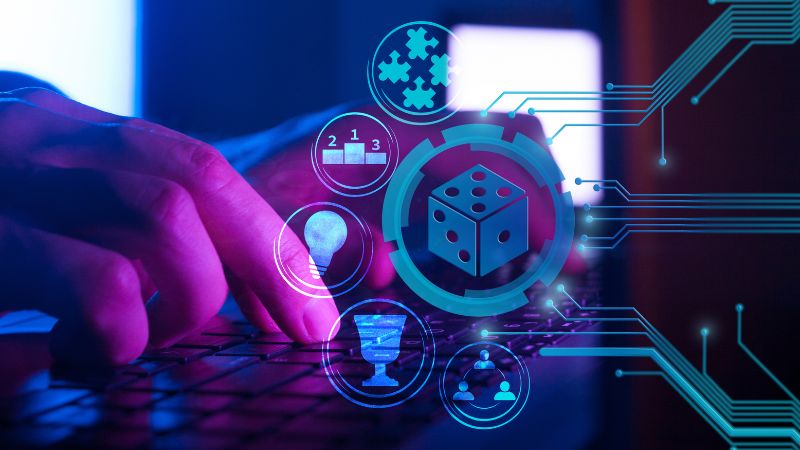Gamification, the integration of game elements into non-game contexts, has revolutionized the field of education, enhancing engagement, motivation, and learning outcomes. This innovative approach leverages intrinsic human desires for achievement, competition, and reward, making learning more enjoyable and effective. Gamification changes the way we learn by adding things like badges, levels, leaderboards, and points. This makes learning more interactive and immersive. In this blog post, we explore the top 10 benefits of gamification in learning, highlighting how this approach can positively impact learners of all ages and backgrounds.
The Top 10 Benefits Of Gamification In Learning
1. Increased Engagement

Gamification in learning captivates learners by incorporating elements such as challenges, rewards, and competition. These aspects create a sense of excitement and motivate learners to actively participate in the learning process. By making learning more enjoyable and interactive, gamification keeps learners engaged for longer periods, leading to better retention of information. Moreover, the element of competition can spur learners to push themselves further and strive for excellence, resulting in a more dynamic and stimulating learning environment.
Also Read:- Professional Development Skills
2. Improved Motivation
One of the best things about gamification is that it can make people more motivated. Gamified learning environments help students set and reach their goals by giving them rewards and praise. Feeling like you’ve accomplished something and made progress keeps people motivated to face challenges and keep learning. Also, the instant feedback that gamified environments offer encourages good behavior, which is another thing that keeps students interested and involved in their learning.
3. Enhanced Learning Experience
For better learning, gamification makes the experience more immersive and interactive. Using gamified learning environments is a fun and effective way to learn difficult ideas and skills because they mimic real-life situations and give immediate feedback. Active participation in the learning process helps students understand and remember what they are learning. This hands-on method of learning helps students feel more connected to the material, which increases the chances that they will remember it and use it in regular life.
4. Personalized Learning Paths
Gamification allows for personalized learning paths based on individual learner preferences and performance. Learners can progress at their own pace, receive targeted feedback, and access additional resources based on their specific needs, ensuring a more tailored learning experience. This personalized approach to learning not only accommodates different learning styles but also helps learners stay motivated and engaged by presenting content in a way that is relevant and meaningful to them.
5. Increased Retention of Information

Studies have shown that gamification can improve information retention by up to 90%. By presenting information in a fun and memorable way, gamified learning environments help learners retain knowledge more effectively compared to traditional learning methods. The interactive nature of gamification allows learners to actively engage with the material, which enhances their understanding and retention of information. Additionally, the use of rewards and incentives in gamified environments reinforces learning and encourages learners to revisit and review the material, further enhancing retention.
6. Fostering Collaboration
Gamification encourages collaboration among learners by promoting teamwork and healthy competition. Through multiplayer games and group challenges, learners can collaborate, communicate, and learn from each other, enhancing their overall learning experience. Collaboration not only helps learners develop important social skills but also enables them to see different perspectives and approaches to problem-solving, which can lead to a deeper understanding of the material.
7. Development of Critical Skills
Gamification helps develop a range of critical skills, including problem-solving, decision-making, and strategic thinking. By presenting learners with challenges and puzzles, gamified learning environments encourage them to think critically and creatively to find solutions. The interactive nature of gamification also helps learners develop skills such as time management, organization, and perseverance, which are valuable in both academic and real-world settings.
8. Immediate Feedback
One of the advantages of gamification is the provision of immediate feedback. Learners receive instant feedback on their performance, allowing them to identify areas for improvement and make corrections in real time, leading to more effective learning outcomes. Immediate feedback helps learners stay on track and motivated, as they can see their progress and make adjustments as needed to achieve their goals.
9. Increased Accessibility
Gamification makes learning more accessible to a wider range of learners, including those with diverse learning styles and abilities. By providing multiple pathways to learning and accommodating different learning preferences, gamification ensures that all learners can benefit from the learning experience. Additionally, the interactive and engaging nature of gamification can help overcome barriers to learning, such as language or cognitive challenges, making it easier for all learners to participate and succeed.
10. Long-Term Engagement

Unlike traditional learning methods, gamification promotes long-term engagement by offering continuous challenges and rewards. This sustained engagement keeps learners motivated and interested in learning, leading to better long-term retention of knowledge and skills. The element of progression in gamified environments, where learners can advance to higher levels or earn more rewards, provides a sense of achievement and encourages them to continue learning and improving over time.
Also Read:- Personalized Learning Strategies
Conclusion
In conclusion, gamification offers a myriad of benefits for learners, educators, and organizations alike. From increased engagement and motivation to improved retention and learning outcomes, the impact of gamification in learning is profound. By harnessing the power of game elements, educators can create dynamic and interactive learning experiences that resonate with learners. As technology continues to advance, the potential for gamification in learning is limitless. Embracing this innovative approach can transform traditional education methods, making learning more accessible, enjoyable, and effective for all.
FAQs
How does gamification improve learning outcomes?
Gamification enhances learning outcomes by increasing engagement, motivation, and retention. By introducing game-like elements, learners are more likely to stay focused and actively participate in the learning process.
Is gamification suitable for all types of learners?
Yes, gamification can be adapted to suit different learning styles and preferences. Whether someone learns best through competition, collaboration, or self-paced exploration, gamification can be tailored to accommodate diverse learning needs.


Leave a Reply